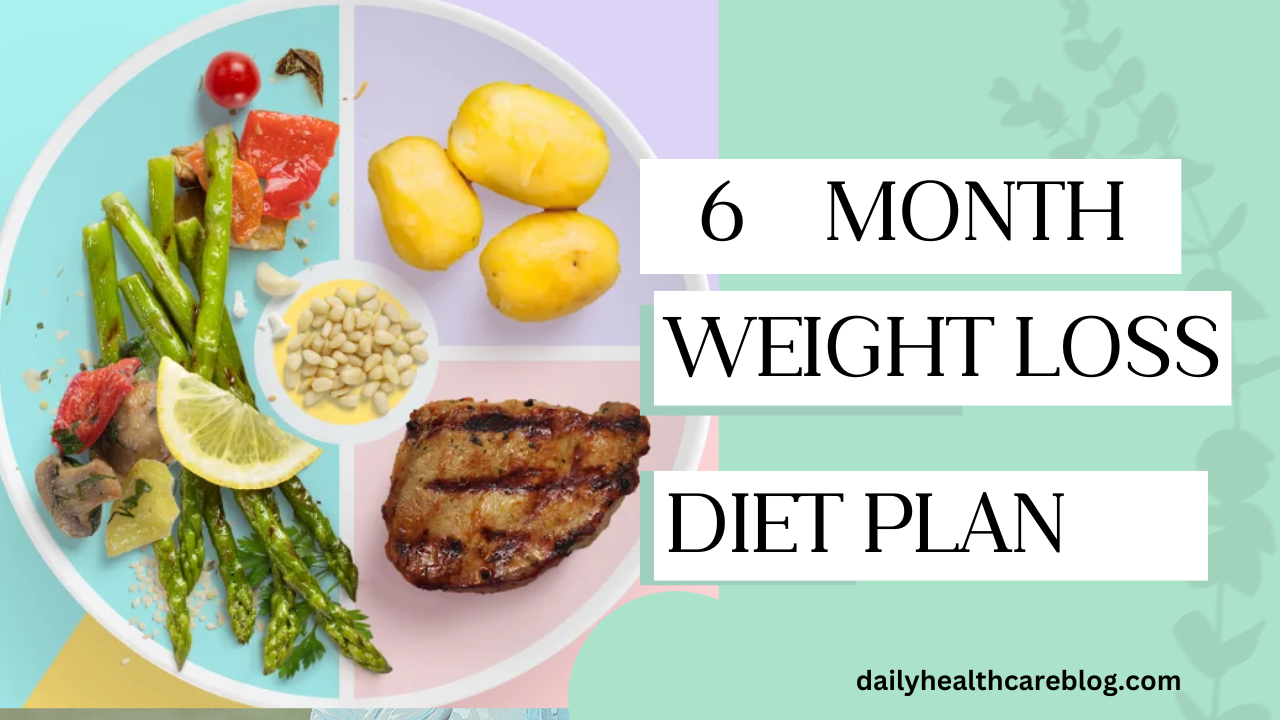6-Month Weight Loss Diet Plan: Your Guide to Sustainable Weight Loss
Introduction
Embarking on a weight loss journey can be challenging, but with a structured plan, achieving your goals becomes much more manageable. A 6-month weight loss diet plan offers a realistic timeline for significant and sustainable weight loss. This article will provide you with a comprehensive guide to crafting and following a diet plan that promotes healthy eating habits, balanced nutrition, and steady weight loss over six months.
Understanding The 6 month weight loss diet plan

Before diving into the diet plan, it’s essential to understand the basics of weight loss. Weight loss occurs when you consume fewer calories than you burn. This can be achieved by:
– Reducing Caloric Intake: Eating fewer calories than your body needs.
– Increasing Physical Activity: Burning more calories through exercise.
A combination of both dietary changes and increased physical activity typically yields the best results.
Setting Realistic Goals
When setting your weight loss goals, it’s important to be realistic. Aim to lose 1-2 pounds per week, which is considered safe and sustainable. Over six months, this translates to a total weight loss of 24-48 pounds.

6-Month Weight Loss Diet Plan
Month 1: Foundation Phase
Goals:
– Establish healthy eating habits
– Gradually reduce calorie intake
Diet Plan:
– Breakfast: Greek yogurt with berries and a handful of nuts
– Snack: Apple slices with almond butter
– Lunch: Grilled chicken salad with mixed greens, cherry tomatoes, cucumbers, and a light vinaigrette
– Snack: Carrot sticks with hummus
– Dinner: Baked salmon with quinoa and steamed broccoli
– Dessert: A small piece of dark chocolate
Tips:
– Drink plenty of water throughout the day.
– Avoid sugary drinks and snacks.
– Start tracking your food intake using a diary or an app.
Month 2: Adjusting Caloric Intake
Goals:
– Fine-tune your calorie intake based on your progress
– Increase vegetable and protein consumption
Diet Plan:
– Breakfast: Oatmeal with banana slices and a sprinkle of chia seeds
– Snack: Cottage cheese with pineapple
– Lunch: Turkey and avocado wrap with a side salad
– Snack: A handful of mixed nuts
– Dinner: Stir-fried tofu with mixed vegetables and brown rice
– Dessert: Fresh fruit salad
Tips:
– Focus on portion control.
– Include a protein source in every meal to stay full longer.
– Limit processed foods.
Month 3: Increasing Fiber Intake
Goals:
– Improve digestive health
– Enhance satiety with fiber-rich foods
Diet Plan:
– Breakfast: Smoothie with spinach, banana, protein powder, and almond milk
– Snack: Pear with a handful of walnuts
– Lunch: Lentil soup with a whole grain roll
– Snack: Red bell pepper slices with guacamole
– Dinner: Grilled shrimp with a quinoa and black bean salad
– Dessert: Greek yogurt with a drizzle of honey
Tips:
– Incorporate more whole grains, fruits, and vegetables.
– Avoid refined carbohydrates.
– Drink a glass of water before each meal.
Month 4: Balancing Macronutrients
Goals:
– Ensure balanced intake of carbohydrates, proteins, and fats
– Maintain energy levels
Diet Plan:
– Breakfast: Whole grain toast with avocado and poached eggs
– Snack: A small smoothie with protein powder, berries, and spinach
– Lunch: Chickpea and vegetable curry with brown rice
– Snack: Sliced cucumber with tzatziki
– Dinner: Baked chicken breast with sweet potato and steamed green beans
– Dessert: A handful of mixed berries
Tips:
– Use healthy cooking methods like baking, grilling, and steaming.
– Avoid trans fats and limit saturated fats.
– Include healthy fats such as olive oil, avocados, and nuts.
Month 5: Enhancing Meal Variety
Goals:
– Prevent diet boredom
– Introduce new healthy recipes
Diet Plan:
– Breakfast: Quinoa porridge with apples and cinnamon
– Snack: Edamame beans
– Lunch: Tuna salad with mixed greens, olives, and a light dressing
– Snack: Rice cakes with almond butter
– Dinner: Baked cod with roasted vegetables and barley
– Dessert: Mango slices
Tips:
– Experiment with new recipes and ingredients.
– Continue to monitor portion sizes.
– Keep your meals colorful with a variety of vegetables.
Month 6: Preparing for Long-Term Maintenance
Goals:
– Solidify healthy eating habits
– Plan for post-diet maintenance
Diet Plan:
– Breakfast: Smoothie bowl with mixed berries, spinach, and a sprinkle of granola
– Snack: Celery sticks with peanut butter
– Lunch: Grilled chicken Caesar salad with a light dressing
– Snack: Greek yogurt with a handful of granola
– Dinner: Vegetable stir-fry with tofu and brown rice
– Dessert: Dark chocolate-dipped strawberries
Tips:
– Reflect on your progress and adjust as needed.
– Develop a plan to maintain your weight loss beyond six months.
– Stay consistent with meal planning and preparation.

FAQs
1. How many calories should I eat to lose weight?
The number of calories you need to consume for weight loss depends on your age, sex, weight, height, and activity level. Generally, a reduction of 500-1000 calories per day from your maintenance level will result in a weight loss of 1-2 pounds per week.
2. Can I have cheat meals on this plan?
Occasional cheat meals are fine, but they should be planned and controlled to avoid derailing your progress. Balance them with healthy meals and increased physical activity.
3. Do I need to exercise on this diet plan?
Yes, combining diet with regular exercise enhances weight loss results and improves overall health. Aim for at least 150 minutes of moderate aerobic activity or 75 minutes of vigorous activity each week, along with muscle-strengthening activities.
4. What should I do if I hit a weight loss plateau?
If you hit a plateau, try adjusting your calorie intake, increasing your physical activity, or varying your workout routine. Sometimes, a slight change in your approach can reignite weight loss.
5. How can I maintain my weight loss after the 6-month plan?
To maintain your weight loss, continue to follow healthy eating habits and regular physical activity. Monitor your weight regularly, and make adjustments as needed to stay on track.
Conclusion
A 6-month weight loss diet plan offers a structured and sustainable approach to achieving your weight loss goals. By focusing on balanced nutrition, portion control, and healthy eating habits, you can lose weight effectively and maintain your results long-term. Remember, consistency and dedication are key to success. With this comprehensive plan, you’re well on your way to a healthier, happier you.
